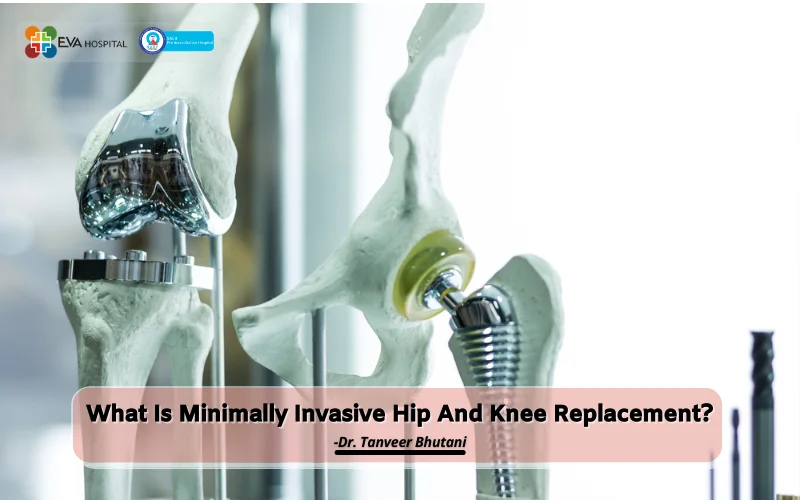What Is Minimally Invasive Hip And Knee Replacement?
 Eva Hospital
Eva Hospital
What Is Minimally Invasive Hip And Knee Replacement?
Minimally Invasive Total Knee Replacement
Total knee replacement is a type of surgery to replace a damaged knee joint. The minimally invasive surgery will have a smaller cut than a traditional TKR.
It requires miniature tools with which the surgeon removes a part of the bones and replaces them with implants to recreate the joint. A layer of plastic is placed between the metal components for smooth gliding.
Minimally Invasive Total Knee Replacement
Total knee replacement is a type of surgery to replace a damaged knee joint. The minimally invasive surgery will have a smaller cut than a traditional TKR.
It requires miniature tools with which the surgeon removes a part of the bones and replaces them with implants to recreate the joint. A layer of plastic is placed between the metal components for smooth gliding.
Minimally Invasive Hip Replacement
The minimally invasive hip replacement is different from the traditional approach where a single, long incision is made to access the hip joint. In this procedure, one or two smaller incisions are made. It reduces pain and recovery time.
However, it may not be suitable for everyone though. At Eva ortho Centre, Ludhiana, your experienced hip replacement surgeon will discuss various surgical prospects with you before proceeding.
Benefits of Minimally Invasive Surgery
Potential benefits of this minimally invasive technique include increased range of motion sooner after surgery, less blood loss during surgery, faster recovery, and a shorter hospital stay. In fact, many patients leave the hospital the same day. Following are the broad benefits:
- Less Pain. Patients who have a minimally invasive procedure have lesser pain & discomfort than patients who have open surgery. This may be because there is often less trauma to the body during minimally invasive surgery. Some open procedures require large sections of muscles and tissue to be cut.
- Shorter Recovery Period. One of the most important benefits of minimally invasive surgery is the shorter recovery period.
- Less Scarring. When there are more miniature incisions or cuts, there is less scarring.
Who Is a Candidate for Minimally Invasive Replacement?
Very experienced in minimally invasive surgeries, Dr. Tanveer Bhutani says,” Practically every patient is a candidate for the minimally invasive TKR at Eva Hospital if his knee structure is stable, there isn’t much bone loss in the knee area, has an optimum weight, and has not had open surgery on the same knee before.”
Minimally invasive total hip replacement is not suitable for all patients. Your doctor will conduct a thorough evaluation and consider several factors before concluding if the procedure is an option for you.
Generally speaking, patients who are thinner, younger, healthier, and more motivated to participate in the rehabilitation process, are better candidates for the minimally invasive approach than the traditional one.
Those who are overweight, have other types of hip deformities, have undertaken hip surgeries before(on the same hip), a very slow recovery.
It means their wounds heal very slowly, both outer and internal. Generally, such patients are operated on with the traditional method of hip replacement.
Recovery Period
Amidst current knee replacement techniques, the patients are encouraged to become mobile much earlier than with the conventional method of knee replacement. Many patients are able to get out of bed either the same day or the next day, with the help of a physical therapist.
The advanced type of pumps that infuse painkillers into the cut, patient-controlled analgesics, and more modern anti-inflammatory drugs are used in combination to expedite the recovery.
Hip surgery is a major procedure that is generally painful and requires plenty of time for recovery. However, its minimally invasive counterpart allows the same results as traditional hip replacement operation, but with less pain and a slower recovery time.
Traditional or Minimal- Which Is Better?
There have been researches but it cannot be generalized which is better for the traditional or minimally invasive Hip replacement. The best decision is taken by an expert surgeon in each case.
There is no single way of doing hip surgeries too. Broadly speaking it is better for you if you are younger, relatively thin, do not have a bone or joint deformations, or osteoporosis, and haven’t had hip surgery before. Experienced surgeons make the decisions after discussions with the patients.
Comparing traditional & minimally invasive knee replacement, the difference lies in the size of the incision. Both have their pros and cons, but minimally invasive surgery can only be performed by very highly skilled orthopedics surgeons.
There are challenges associated with this type of technique. The surgeon must be highly skilled & experienced with this novel approach, which is why this type of surgery is less common.
Also Read: Types of Hip Replacement Surgeries
Conclusion
Similar to traditional joint replacement surgery, minimally invasive surgery should be conducted by a well-trained, extremely experienced orthopedic surgeon.
You may discuss with your doctor about his or her experience with this type of modern technique, both in the case of hip and knee.
If you have questions about these procedures or any of our other ortho services, you may contact us on phone and make an appointment at Eva Hospital.
Minimally Invasive Hip Replacement
The minimally invasive hip replacement is different from the traditional approach where a single, long incision is made to access the hip joint. In this procedure, one or two smaller incisions are made. It reduces pain and recovery time.
However, it may not be suitable for everyone though. At Eva ortho Centre, Ludhiana, your experienced hip replacement surgeon will discuss various surgical prospects with you before proceeding.
Benefits of Minimally Invasive Surgery
Potential benefits of this minimally invasive technique include increased range of motion sooner after surgery, less blood loss during surgery, faster recovery, and a shorter hospital stay. In fact, many patients leave the hospital the same day. Following are the broad benefits:
- Less Pain. Patients who have a minimally invasive procedure have lesser pain & discomfort than patients who have open surgery. This may be because there is often less trauma to the body during minimally invasive surgery. Some open procedures require large sections of muscles and tissue to be cut.
- Shorter Recovery Period. One of the most important benefits of minimally invasive surgery is the shorter recovery period.
- Less Scarring. When there are more miniature incisions or cuts, there is less scarring.
Who Is a Candidate for Minimally Invasive Replacement?
Very experienced in minimally invasive surgeries, Dr. Tanveer Bhutani says,” Practically every patient is a candidate for the minimally invasive TKR at Eva Hospital if his knee structure is stable, there isn’t much bone loss in the knee area, has an optimum weight, and has not had open surgery on the same knee before.”
Minimally invasive total hip replacement is not suitable for all patients. Your doctor will conduct a thorough evaluation and consider several factors before concluding if the procedure is an option for you.
Generally speaking, patients who are thinner, younger, healthier, and more motivated to participate in the rehabilitation process, are better candidates for the minimally invasive approach than the traditional one.
Those who are overweight, have other types of hip deformities, have undertaken hip surgeries before(on the same hip), a very slow recovery.
It means their wounds heal very slowly, both outer and internal. Generally, such patients are operated on with the traditional method of hip replacement.
Recovery Period
Amidst current knee replacement techniques, the patients are encouraged to become mobile much earlier than with the conventional method of knee replacement. Many patients are able to get out of bed either the same day or the next day, with the help of a physical therapist.
The advanced type of pumps that infuse painkillers into the cut, patient-controlled analgesics, and more modern anti-inflammatory drugs are used in combination to expedite the recovery.
Hip surgery is a major procedure that is generally painful and requires plenty of time for recovery. However, its minimally invasive counterpart allows the same results as traditional hip replacement operation, but with less pain and a slower recovery time.
Traditional or Minimal- Which Is Better?
There have been researches but it cannot be generalized which is better for the traditional or minimally invasive Hip replacement. The best decision is taken by an expert surgeon in each case.
There is no single way of doing hip surgeries too. Broadly speaking it is better for you if you are younger, relatively thin, do not have a bone or joint deformations, or osteoporosis, and haven’t had hip surgery before. Experienced surgeons make the decisions after discussions with the patients.
Comparing traditional & minimally invasive knee replacement, the difference lies in the size of the incision. Both have their pros and cons, but minimally invasive surgery can only be performed by very highly skilled orthopedics surgeons.
There are challenges associated with this type of technique. The surgeon must be highly skilled & experienced with this novel approach, which is why this type of surgery is less common.
Also Read: Types of Hip Replacement Surgeries
Conclusion
Similar to traditional joint replacement surgery, minimally invasive surgery should be conducted by a well-trained, extremely experienced orthopedic surgeon.
You may discuss with your doctor about his or her experience with this type of modern technique, both in the case of hip and knee.
If you have questions about these procedures or any of our other ortho services, you may contact us on phone and make an appointment at Eva Hospital.
[/vc_column_text][/vc_column][/vc_row]









